How to make it work for your brand with Facebook’s new changes
After the new Facebook News Feed changes, all of the marcomm industry has been left wondering what are the best ways of keep on bringing success for the brands and the companies.
We are offering you some solutions that we believe will help you and your business:
Put more emphasize on the content and its value. Even you will post less frequently, try and create content that will stimulate the conversation, bringing more comments and shares.
Avoid click and engagement bait
Use Facebook Live. Live videos get the best interaction of Facebook of all the content posted and,moreover, bring instant interaction and reaction from the followers. A manner to attract more people to your live video is to announce your followers you will have a video session and when it will happen, plus add people in your video and invite people to watch. Moreover, the viewers can interact by posing open questions or by submitting questions during the live feed.
Use the “See First” option. What it happens is that when your followers activate this option they’re less likely to miss your updates. All they have to do is click on “Following” and then “See First” on your page and everything is settled.
Get into Messenger Chatbots, learn about them and use them. They will allow you to nurture leads and sell.
“Businesses in the travel, finance, media and entertainment, health, and retail sectors in particular have all found success with these pocket-sized personal assistants. For example, you can open up Facebook Messenger at breakfast and ask your weather bot what Mother Nature has in store for you that day. Then you can ask your favorite newspaper bot for the latest sports or business headlines. Planning a trip? Message a travel bot for flights and hotel recommendations, to rent a car, and more. Bots use AI technology to understand your question, find the right response, and deliver it in as conversational and “human” a way as possible,” wrote Rob Mathison for Hootsuite.
Learn how to use to perfection Facebook ads. Even the advertising politics are in a continuous change, mastering your ads’ strategy is the way to reach the best your target.
The digital out-of-home advertising is already blooming
The share of global advertising spend going to out-of-home (OOH) advertising remains stable at 6 percent, shows ‘Why Out Of Home Performs’, a joint study by Magna Intelligence and Rapport, IPG Mediabrand’s out-of-home agency, into OOH’s continued growth and impact. The report was based on findings from an analysis of the global OOH industry and OOH advertising in 70 countries. This is largely down to major investment in digital OOH (or DOOH), which is growing in every environment and has seen unit numbers jump 70,000 to 300,000 worldwide in two years, and revenue increase by 30 percent.
Digital OOH is boosting advertising revenues by creating more opportunities for marketers in premium locations like airports or malls, thus increasing the revenue per panel multiple times. Although digital units account for only 5% of the global OOH inventory, they already generate 14% of total advertising revenues. In fact, DOOH already accounts for 30% of revenues in some markets like the UK and Australia, and the global share is predicted to grow to 24% globally by 2021.
“With the explosive growth of digital-out-of-home (DOOH), the diversified lifestyle touch points it reaches, and the veritable mountain of mobile driven audience data, we are best positioned to accurately, and in real-time, track audiences and deliver contextually relevant messages through out-of-home media. OOH’s sustained growth on a global scale will further enable us to create engaging consumer experiences,” said Mike Cooper, Global CEO Rapport.
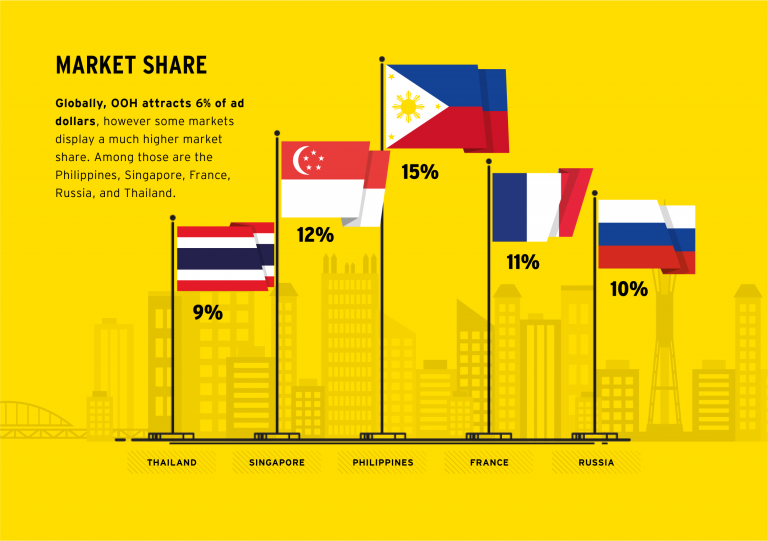
source: Campaign Asia
“The digital-out-of-home market is a return to advertising’s roots, quietly shifting the industry by way of re-imagining the classic advertising experience. Nearly $4.5 billion is expected to be spent on DOOH advertising in the U.S. by 2019, an increase of approximately $1.2 billion from 2016. Zenith forecasts that DOOH will grow faster globally than all other buying methods, and PricewaterhouseCoopers predicts that DOOH advertising revenues will overtake traditional media spend in 2020, growing at a rate of 15% a year for the next four years,” writes AdAge.com.
According to MAGNA, OOH advertising is now a $29 billion market, responsible for approximately 6% of the $500 billion global advertising spending. However, OOH market share increases to 10% to 12% in some countries, including France and Russia, compared with other media categories including Internet, TV, print and radio. OOH market share has remained stable in the last five years, hovering around 6%. However, as part of its increasing importance in the media mix, OOH market share has increased from 8% to 10% of traditional media advertising spend, which includes TV, print, radio and out-of-home, among other categories.
MAGNA Intelligence, in partnership with Rapport, conducted an in-depth survey in 22 key markets including Argentina, Australia, Belgium, Canada, China, Denmark, France, Germany, India, Italy, Japan, Malaysia, Mexico, Netherlands, Norway, Philippines, Russia, Singapore, Spain, Thailand, United Kingdom and the United States. The objective of the survey was to assess OOH advertising’s sustained growth and impact during a period where offline marketing budgets are stagnating and other media categories are struggling.
Moreover, MAGNA showed in another study launched in June, that in the USA, Out-of-Home (OOH) advertising is expected to grow +2% to $7.9 billion in 2017, including cinema. MAGNA reduces its 2017 growth forecast following weak first quarter advertising sales, which grew by just +0.3% in a sudden slowdown, as seven of the last eight quarters had shown year-over-year growth of +3% or more. The 1Q17 stagnation occurred as a result of several key verticals reducing spend, including both automotive and food & beverage, which both experienced double-digit declines. This offset the continued growth from tech brands (e.g. Google, Apple, Hulu and Netflix) that have driven OOH sales over the last two years.
The DOOH market encapsulates everything from digital billboards to screens in elevators to screens on jukeboxes. Unlike internet or mobile advertising, it allows advertisers to reach target audiences in a specific, real-world context. Instead of interrupting an internet user’s online experience with an ad, it’s focused on marketing to consumers when they are “on the go” in public places or in transit. Due to its specifications, the technology has the opportunity to give to its target the message in a format that’s automated, dynamic and interactive.
“The DOOH space presents a major opportunity for creatives, technologists and consumers alike. We see DOOH’s effectiveness in the numbers: the 2016 Nielsen OOH ad study found 91% of U.S. residents age 16 or older, who have traveled in a vehicle in the past month, noticed some form of OOH, and 79% noticed OOH in the past week. The same Nielsen digital billboards study found 71% of digital billboard viewers find those ads to stand out more than online ads. Ultimately, the emerging digital-out-of-home market is groundbreaking in its interactive technology, but it’s also a return to advertising’s roots and the original purpose around advertising: to provide an engaging and useful service to the public,” writes AdAge.
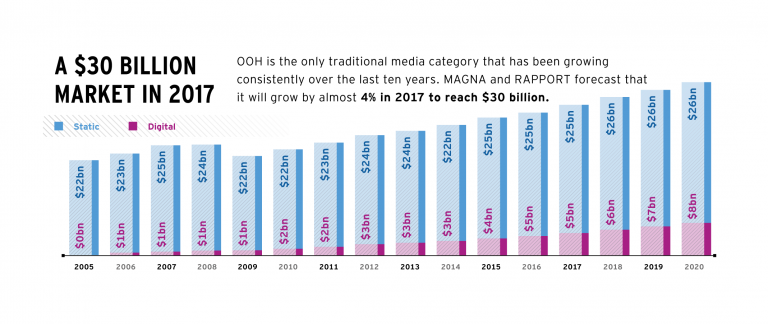
Globally, in 2016, the OOH market was worth $28 billion in net advertising, according to Magna’s report, and is predicted to grow by 4 percent per year to reach $33 billion by 2021. Behind this growth is an ever-more concentrated supply-side market, in which the top international OOH media owners are continuing to expand their influence: the six main global vendors (in order of 2016 revenue size, JCDecaux, Clear Channel, Outfront, Lamar, Stroer and Exterior) now control almost 40 percent of the whole market. By 2021, the report predicts small, but significant changes, in the environments most used for OOH. Use of billboards, currently the top revenue-generating segment and performing particularly well in India, Russia and the US, will drop 4 percent from 45 to 41 in the next five years. Street furniture and transit, meanwhile, are due to grow, respectively, from 31 to 34 percent and from 14 to 15 percent as local authorities become more willing to partner with OOH vendors. A series of major contracts—typically over 10 years long—in big cities are also in the process of renewal, the first time this has happened in the era of DOOH and programmatic opportunities, which partly explains DOOH’s recent giant revenue leap.
According to APAC, while the US is the largest OOH market, valued at $7.1 billion last year, APAC countries Japan ($4.7 billion) and China ($3.1 billion) come in at second and third position and per capita spending on OOH amounts to a record $38 per year in Japan, compared to $22 in the US. Singapore spends the second highest amount per capita at $36 a year. In the Philippines, meanwhile, OOH accounts for one of the highest percentage shares of overall ad spend in the world, at 15 percent compared to the global share of 6 percent. Singapore (12 percent) and Thailand (9 percent) also exceed the worldwide average.
Singapore’s OOH ads have the highest reach range of any other APAC market, with a penetration of 70 to 80 percent of the relevant population, due to its concentrated levels of urbanisation. Australia’s have the second highest, reaching 60 to 70 percent, but neither matches the reach of OOH ads in Argentina, which are considered seen by a huge 85 to 95 percent of the population.
In Australia, DOOH represents more than a third of total OOH spend, which the report attributes to a sophisticated advertising market and a population relatively concentrated in a few urban centers.
In China, the total OOH spend about matches other markets, it is one of the top five global markets in terms of penetration of digital, led by the transit segment. By 2021, MAGNA predicts that digital growth will have doubled, while OOH growth will be stagnating, partly due to lack of interest in non-digital inventory.
“OOH’s natural convergence with other digital media has hurt most other ad forms. OOH complements digital media by amplifying and enhancing it. This phenomenon has brought additional ad revenue to OOH, while most other media have experienced revenue losses as a result of the growth in digital.OOH has benefited from other new technologies, too, such as social media and mobile. Many OOH media campaigns are now picked up on social media, which greatly amplifies the total viewership. When consumers are on mobile devices, OOH is typically one of the last ad forms they’re exposed to just before important path-to-purchase decisions,” explained Steve Nicklin, Vice President of Marketing, OAAA, for billboardinsider.com.
The innovative opportunities provided by the digital platform have provided the OOH industry with new thinking and new ideas. Moreover, in the USA, as shown by the USA Touchpoints/RealityMine study, OOH and Today’s Mobile Consumer, consumers spend more time with OOH than any other form of advertising media except TV. The findings are supported by the 2016 Nielsen OOH ad study that found that 91% of US residents age 16 or older, who have traveled in a vehicle in the past month, noticed some form of OOH, and 79% have noticed OOH in the past week. Their research also discovered impressive levels of engagement, with 82% of billboard viewers reporting they look at the advertising message at least some of the time; and over one-third looking at the billboard ad each time or almost each time they noticed one. The Nielsen digital billboards study found 71% of digital billboard viewers find them to stand out more than online ads.
OOH is expanding to brand new environments. Digital screens have allowed OOH advertising vendors to penetration niche environment allowing to reach young urban population that is otherwise hard to reach by traditional media: offices, elevators, taxi, gyms, bars, retail etc. The “Digital Place-Based” segment offers targeting capabilities and programmatic opportunities. Moreover, OOH becomes addressable and experiments with programmatic. Initially developed to automate the trading of online display ads, the programmatic technologies are now being used in to buy and optimize ad campaigns on connected DOOH units.
Programmatic techniques not only optimize the workflow of media-buying but help brands deliver the right ad in the right place and at the right time, using consumer data and mobile location data. Giving advertisers the ability to plan, buy, optimize and measure the effectiveness of their outdoor campaigns through an online platform represents the natural evolution of OOH’s technology-driven transformation with many vendors developing Private Marketplaces (PMP).
Besides that, DOOH is going social. “There are two main avenues DOOH is being used to complement social campaigns, either through integration or through content creation,” says Neil Morris, founder and CEO of UK-based creative production house Grand Visual.
How will the house of 2025 look like?
The word of the future is smart. Even in the housing and design department. And as the technology is evolving at a huge rate, we wonder how it will look like in the future.
If the third industrial revolution was about using electronics and information technology to change economic systems and the way we live, the fourth will be characterized by disruptions stemming from a merger of the digital and physical worlds.
According to Yoshiaki Fujimori, President & CEO of the LIXIL Group Corporation for weforum.org, what we are seeing now with the emergence of the fourth industrial revolution is the development of cognitive architecture, which enables our living spaces to be tailored for personal and family preferences. This is set to have a profound effect on our quality of life.
“The home will become a natural, intuitive, extension of you. Rather than the occupant adapting to the home, we’ve entered an exciting new phase where the home works for those who live inside it. Development of AI, robotics and other advanced technologies for applications within the living space has been underway for some time, but are gaining increased attention,” said Yoshiaki.
Kevin Foreman, quoted by wired.com, believes that homes will soon become intelligent enough to distinguish between family members and guests within physical spaces and adapt to individual needs based on biometrics like fingerprints, body temperatures and even the rhythm of our own heartbeats. Therefore, in the very near future as you walk through your home, a small device worn around the wrist will authenticate your identity by pairing itself to your specific heartbeat, allowing your home to automatically adjust the lighting, room temperature and play custom music based on personalized preferences and pre-configured profiles.
Meanwhile, companies such as Nest are creating connected products that recognize homeowners’ preferences and adjust settings like temperature automatically or via an app.
In the same way that primary energy use in the home shifted from lighting to more complex devices and appliances, Internet traffic is following a similar pattern. Professor Klaus Schwab’s report on the Fourth Industrial Revolution predicts that the tipping point will be when over 50% of internet traffic delivered to homes is for appliances and devices as opposed to entertainment and communication, and that we can expect this tipping point to have occurred by 2025.
Here are some of the aspects that will make our lives easier:
Robots everywhere
According to the specialists, home appliances will become more self-aware, an example being the iRobot Roomba 780 which can be set to vacuum on a schedule, find its way around furniture, and even stay within a specific zone. In 15 years, devices for cleaning windows, sweeping the floor, and even making minor repairs will do their work inconspicuously. Yet, even the predictive technology in your home – using less energy during one week because the weather forecast says you will need more heat for an upcoming cold spell – has robotic intelligence.
Moreover, the journalists from http://www.plymouthherald.co.uk believe that in 15 years the companion robots will be available as part of team of collaborating robots. They will be able to monitor the wellbeing of their elderly charges, remind them to take their medicines, call relatives or cariers in an emergency, and perform simple tasks. Their owners will be able to give them shopping lists – by voice or by computer tablet – which the companions will convey via a “warden” robot who will pass it on to the outside robot, which will do the shopping. Your children might also benefit by having a “teacher” robot to help with the homework.
Solar photovoltaics on every roof
Over 15 per cent of houses in Australia already have rooftop solar installed, and forecasts show by the 2020s, solar and wind will be the cheapest way of producing electricity. Companies are already combining satellite imagery with algorithms to understand the savings you can make from your rooftop. And given the massive cost reductions of 99 per cent since 1970, and 80 per cent since 2008, it’s easy to foresee that solar photovoltaics will be ubiquitous by 2025.
Still according to plymouthherald, by 2030 the mantra will become “Energy, energy, energy”. Many new buildings will be carbon-neutral, meaning they will produce all of the energy they need without burning fossil fuels, and will even export electricity.
Merlin Hyman, chief executive of Regen SW, said: “For most of us our regular bill is the only time we think much about how we use energy in our homes. However, with the introduction of smart meters that is set to change. In the future we will be flexible to use energy when it is cheapest – for example charging electric cars overnight, or heating our water during the day. We may even export power back to the grid from batteries in the house if there is a surge of demand and a high price.”
Everyone will have to adapt to the future of energy – and that includes the suppliers. Nigel Turvey from Western Power Distribution predicts that the growth of renewable energy will really take off after 2025.
Smart appliances
In the house of tomorrow everything will be connected through technology and the new, smart appliances are a big part of it. The interaction with the user will be easy and smooth, they will increasingly be able to learn what you want and to have it on hand.
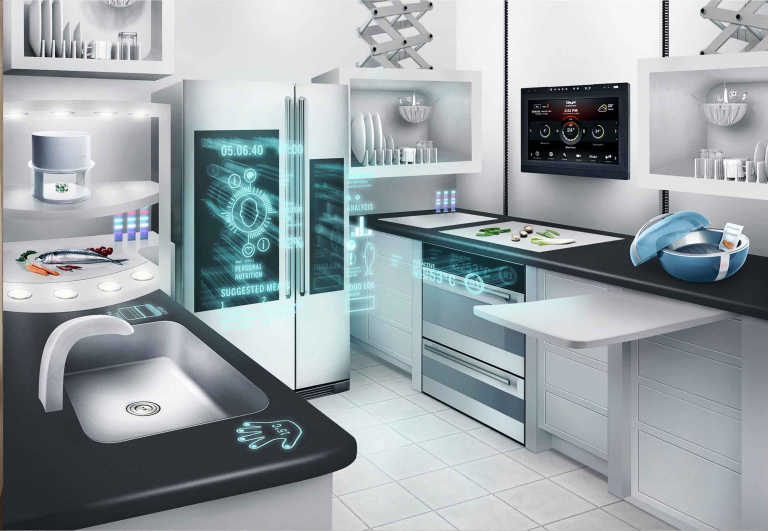
source: Emaze
The old-fashioned light switch will eventually disappear, and we will control lighting using smartphone or touchscreen panels – or even voice-activation. Smart thermostats like NEST and Hive allow you manage every minute of your home’s heating schedule from a smartphone, tablet or computer. So coming home from a holiday to a cold house will be a thing of the past.
The days of the chip-stop on the way home when you’re too tired to cook may be numbered too. Your fridge, connected to the Internet of Things, will not even need to ask you for a shopping list: it can tell when you’re running low, and place an order with the supermarket. This technology is actually here in some countries, not in the far-away future.
When it comes to novelties, ” June” is a smart oven, expected to ship this year. Its intelligent system can recognize the dish and know exactly how to cook it to perfection. June can be controlled with your iPhone or iPad, and you can monitor cooking with a live video stream.
Moreover, the appliances in one’s house will operate autonomously and interact with each other and even today one still has to load the washing machine, by 2030 one will just walk away, leaving the machine to decide how dirty the clothes are, and when to switch on to take advantage of the cheapest and most plentiful electricity.
Smart living & content
Virtual reality can turn couch potatoes into globetrotters. And they won’t even have to get up to hunt for a DVD: centralized streaming will give instant access to entertainment. The TV set will no longer dominate the living room: ultra-thin OLED displays will allow us to stick our TV screen to the wall, and holographics will bring characters right into the room.
The future home will be intelligent enough to predict what you want to do with content. Dell spokesperson Chad Andrews told TechRadar about a concept where media knows more about the playback device that we can even conceive today: adaptive music, movies, and photos that change shape and size (and color profiles) based on whether you are viewing them in the living room on an HDTV or on a tablet in your office. Data centers will predict the media you want to use and provide that media in the proper formats and sizes. Moreover, the number of screens in the future home will increase exponentially. To avoid overload, the visual information will integrate better into appliances, mirrors, and even the tools and household items you use. There might be flexible display on your cleaning detergent with instructions for use, or a display in the garage that reminds you about home maintenance.
Speech enabled
Whether you are a fan of Apple Siri or not, one thing is clear: speech tech has finally hit the mainstream. Your home will understand what you say. Already, Samsung and others are developing smart televisions that understand spoken commands. In the future, your home will respond to voice requests for the news, sports, and entertainment. More importantly, your home will use advanced algorithms that determine when you are speaking to the home or to your spouse – sensing a change in your tone, or interpreting a phrase that must be an instruction to change the house temperature. How about that level of smart?
Knowing you better that you know yourself
The future home will be smart enough to know what you want – sometimes even before you want it. Ford has already started experimenting with the Google prediction engine to guess where you want to go at certain times of the day. Your house will also know your preferences: when you start a movie, the lights will dim to the level you normally use. Moisture sensors in your lawn will learn how much you use a sprinkler system and adjust patterns accordingly.
Worldwide technology trends in 2017
The technology is advancing nowadays even faster than the speed of light. Its advances and upgrades can seem overwhelming, thankfully though we have the specialists to help us understand where we are heading and how to handle it. The Deloitte’s 2017 report outlines how companies presently must sift through the promotional noise and hyperbole surrounding emerging technologies to find those solutions offering real potential. To realize that potential, they should become ‘kinetic’ organizations—companies with the dexterity and vision required to thrive amid ongoing technology-fueled disruption.
While the report identifies key trends that will likely revolutionize enterprise technology in the next 18-24 months, the exponentials chapter looks even farther into the future, describing four key areas that blend science and applied technologies.
The 2017 trends identified by Deloitte, digitaltrends.com, Forbes and Gartner are as follows:
IT unbounded—The boundaries surrounding IT are fading as technology becomes integral to almost every business function and relationship.
IoT and Smart Home Tech
A multitude of wireless technologies now exist to serve your smart home needs — Zigbee, Z-Wave, Bluetooth, Wi-Fi, and more. And there’s more smart home platforms to consider than ever before too — Wink, SmartThings, Iris by Lowe’s, even systems from security providers like ADT and big brands like Comcast. While centralization in theory should make things easier, it’s made it worse.
The AI world will have a head-on collision with the Internet of Things in 2017, too, Gartner predicts. IoT is where everyday items get chips or sensors, and apps, and join the internet — from your car to your toothbrush. It makes total sense that the apps that control IoT devices will also make use of machine learning.
In 2017, watch for devices to start to communicate and help each other make decisions. “As intelligent things, such as drones, autonomous vehicles and smart appliances, permeate the environment, Gartner anticipates a shift from stand-alone intelligent things to a collaborative intelligent things model,” Gartner says. Gartner estimates that six billion connected “things” will be actively requesting support from AI platforms by 2018.
The total IoT market is estimated to grow from $157.05 billion in 2016 to $661.74 billion by 2021, predicts Markets and Markets.
Artificial Intelligence and Automation
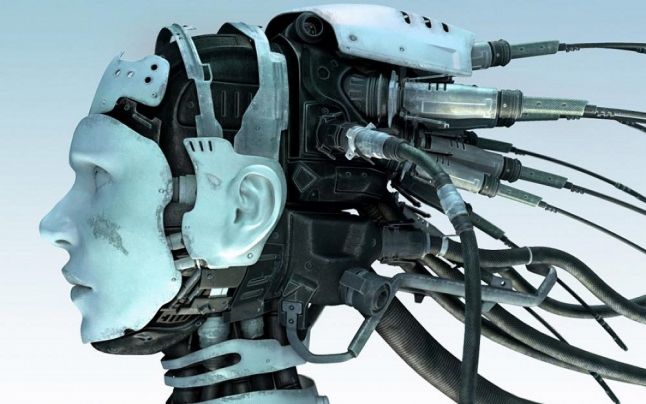
AI and chatbots that understand context a whole lot better than ever before. More and more jobs will also be automated, we’ll also see smart devices gain from increased automation, learning your patterns and preferences without you needing to tell them and making better and more accurate suggestions and recommendations.
Research firm Markets and Markets estimates that the AI market will grow from $420 million in 2014 to $5.05 billion by 2020.
Artificial Reality and Virtual Reality
According to Gartner, virtual reality (VR) and augmented reality (AR) transform the way individuals interact with each other and with software systems creating an immersive environment. For example, VR can be used for training scenarios and remote experiences. AR, which enables a blending of the real and virtual worlds, means businesses can overlay graphics onto real-world objects, such as hidden wires on the image of a wall. Immersive experiences with AR and VR are reaching tipping points in terms of price and capability but will not replace other interface models. Over time AR and VR expand beyond visual immersion to include all human senses. Enterprises should look for targeted applications of VR and AR through 2020.
As forbes.com points out we’ve already seen some major steps forward for augmented reality (AR) and virtual reality (VR) technology in 2016. Oculus Rift was released, to positive reception, and thousands of VR apps and games followed. We also saw Pokémon Go, an AR game, explode with over 100 million downloads. The market is ready for AR and VR, and we’ve already got some early-stage devices and tech for these applications, but 2017 it’s going to be the year we see things really take off. Once they do, you’ll need to be ready for AR and VR versions of practically everything—and ample marketing opportunities to follow.
“Look for navigation services to get even more specific — maps in a store’s app, for example, to direct you to a specific aisle to find exactly what you’re looking for. So called “augmented reality,” where virtual objects and information are displayed on top of the physical world, will make its way to our phones. Search engines are already expanding on image search, allowing you to point your camera at something and search for information based on what the lens takes in,” said Ed Oswald for digitaltrends.com.
IDC predicts that worldwide revenues for the augmented reality and virtual reality (AR/VR) market will grow from $5.2 billion in 2016 to more than $162 billion in 2020.
Advances in computer vision and pattern recognition allow companies to unlock insights from unstructured data that until now, have been lost in the dark.
Machine intelligence is helping companies make better decisions, embed complex analytics into customer and employee interactions, and—with adoption of bots and robotic process automation—automate increasingly difficult tasks.
“Throughout 2017, I expect to see machine learning updates emerge across the board, entering almost any type of consumer application you can think of, from offering better recommended products based on prior purchase history to gradually improving the user experience of an analytics app. It won’t be long before machine learning becomes a kind of “new normal,” with people expecting this type of artificial intelligence as a component of every form of technology,” predicts Jayson DeMers for Forbes.
Mixed reality (Physical-Digital Integrations)
Companies are exploring more immersive and engaging ways to combine the physical world and digital systems, creating a new, mixed reality that’s more natural, intuitive and intelligent.
Mobile devices have been slowly adding technology into our daily lives. It’s rare to see anyone without a smartphone at any given time, giving us access to practically infinite information in the real-world. We already have things like site-to-store purchasing, enabling online customers to buy and pick up products in a physical retail location, but the next level will be even further integrations between physical and digital realities. Online brands like Amazon will start having more physical products, like Dash Buttons, and physical brands like Walmart will start having more digital features, like store maps and product trials.
Open standards, cloud-first designs and loosely coupled architectures are the norm in start-ups. Now, large enterprises have similar ambitions.
Traditional business products are being reimagined as services as organizations modernize core systems and the technology stack.
Digital Twin
According to Gartner, within three to five years, billions of things will be represented by digital twins, a dynamic software model of a physical thing or system. Using physics data on how the components of a thing operate and respond to the environment as well as data provided by sensors in the physical world, a digital twin can be used to analyze and simulate real world conditions, responds to changes, improve operations and add value. Digital twins function as proxies for the combination of skilled individuals (e.g., technicians) and traditional monitoring devices and controls (e.g., pressure gauges). Their proliferation will require a cultural change, as those who understand the maintenance of real-world things collaborate with data scientists and IT professionals. Digital twins of physical assets combined with digital representations of facilities and environments as well as people, businesses and processes will enable an increasingly detailed digital representation of the real world for simulation, analysis and control.
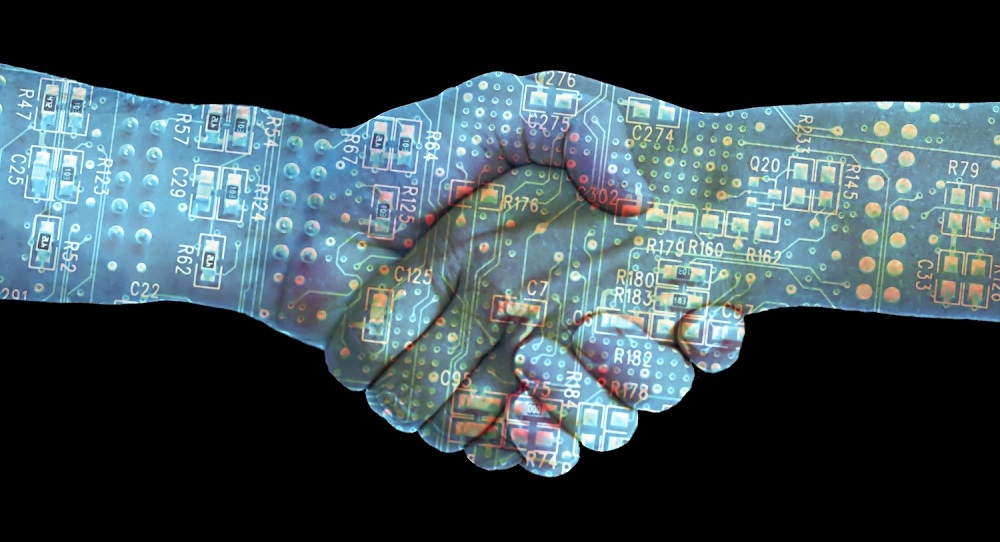
source: Blockchain Technologies
Blockchain, a way of distributing a database across many far-flung computers, is emerging as the mainstay for digital identities in the emerging trust economy.
Exponentials watch list – Advances in disruption forces like synthetic biology, energy storage, quantum computing, and nanotech could exponentially transform the way we do business. Remember the big Bitcoin phenom of 2015? It turns out that the coins themselves could be far less valuable than the underlying technology, called blockchain, that created them.
Consortiums have sprouted up to create new blockchain apps for the financial industry, for health care, and so on.
Market Reports Hub believes the global blockchain technology market will grow from $210.2 million in 2016 to $2.3 billion by 2021.
Advances in disruption forces like synthetic biology, energy storage, quantum computing, and nanotech could exponentially transform the way we do business.
Humanized Big Data (visual, empathetic, qualitative)
Big data has been a big topic for the past five years or so, when it started making headlines as a buzzword. According to Forbes, the idea is that mass quantities of gathered data—which we now have access to—can help us in everything from planning better medical treatments to executing better marketing campaigns. But big data’s greatest strength—its quantitative, numerical foundation—is also a weakness. In 2017, I expect we’ll see advancements to humanize big data, seeking more empathetic and qualitative bits of data and projecting it in a more visualized, accessible way.
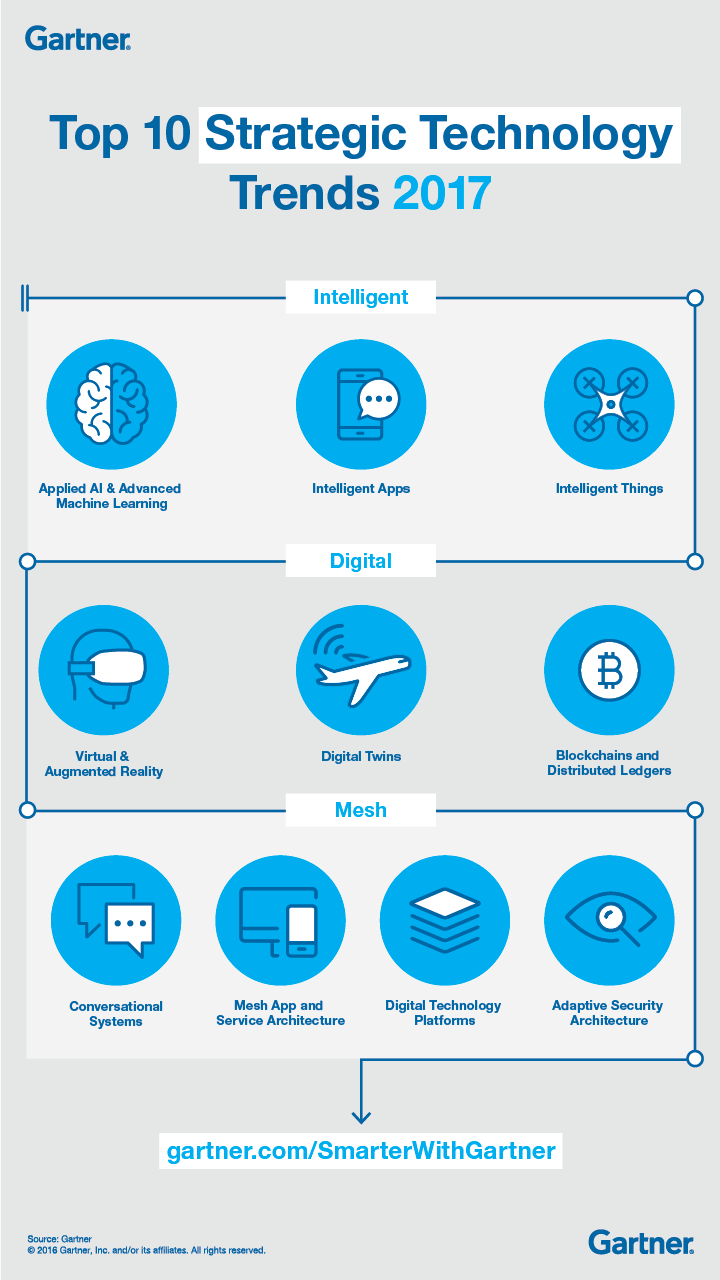
Adaptive Security Architecture
“The evolution of the intelligent digital mesh and digital technology platforms and application architectures means that security has to become fluid and adaptive. Security in the IoT environment is particularly challenging. Security teams need to work with application, solution and enterprise architects to consider security early in the design of applications or IoT solutions. Multilayered security and use of user and entity behavior analytics will become a requirement for virtually every enterprise,” points out Gartner.

